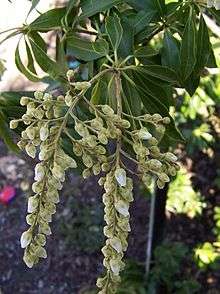Pieris floribunda
| Pieris floribunda | |
|---|---|
 | |
| Pieris floribunda flower raceme in March | |
| Scientific classification | |
| Kingdom: | Plantae |
| (unranked): | Angiosperms |
| (unranked): | Eudicots |
| (unranked): | Asterids |
| Order: | Ericales |
| Family: | Ericaceae |
| Genus: | Pieris |
| Species: | P. floribunda |
| Binomial name | |
| Pieris floribunda Benth. & Hook.f.[1] | |
| Synonyms[2] | |
| |
Pieris floribunda is a North American species of broadleaf evergreen shrub, a member of the Fetterbush genus in the Blueberry Family (Ericaceae). It is commonly known in North America as mountain fetterbush[3] or mountain andromeda.[4] All parts of Pieris floribunda are poisonous if ingested.[5] It is a rare plant to find in landscapes because it is difficult to propagate and it often does not adapt well to cultivation. However, there are a few specialty and native plant nurseries that sell some, overcoming the more difficult propagation. It is a handsome plant and should be used more in horticulture, as recommended by Dr. Michael A. Dirr in his "Manual of Woody Landscape Plants." In landscapes it should be grown in full to part shade, out of windy locations, and have a good quality soil with lots of organic matter that is acid of pH 4.5 to 6.5
The very similar Japanese andromeda, Pieris japonica, is very common in eastern landscapes of the US and occasionally in midwestern ones. It is easy to propagate, easily adapts to cultivation, and differs most in having very pendulous flower clusters rather than erect ones as the American species. The mountain fetterbush is less subject to damage from the Azalea lacebug that often infests the Japanese species. There is a cultivar of a hybrid between the American and Japanese species called 'Brouwer's Beauty' that does adapt easily to cultivation and bears intermediate flower clusters that are erect and yet drooping also.
Habit
Pieris floribunda is a bushy shrub growing to around 3 to 6 feet high with oval shiny, leathery leaves which are normally evergreen, but may shed in a harsh winter to brown and persist until spring. It has erect or erect with just slightly nodding panicles of white urn-shaped flowers that form in autumn as erect pink buds. The brown, dry fruit is a slightly angled globular capsule about 1/2" long in autumn and persisting until late April. The gray-brown bark is shaggy and peeling when mature.[5][6][7]
Distribution
Pieris floribunda is native to the eastern United States, primarily the southern Appalachian Mountains in the States of Tennessee, North and South Carolina, Georgia, Virginia and West Virginia.[8] It thrives in areas of land disturbed by human activity. In common with other members of Pieris, it grows better on well drained soils. [4]
References
- ↑ "Ericaceae - Pieris floribunda Benth. & Hook.f.". International Plant Names Index. Retrieved 28 March 2014.
- ↑ The Plant List, Pieris floribunda (Pursh) Benth. & Hook. f.
- ↑ "Pieris floribunda". Natural Resources Conservation Service PLANTS Database. USDA. Retrieved 31 January 2016.
- 1 2 "Pieris floribunda". Ladybird Johnson Wildflower Center, University of Texas.
- 1 2 "Native Plants". Pieris floribunda. New England Wild Flower Society.
- ↑ Flora of North America, Pieris floribunda (Pursh) Bentham & Hooker f., 1876. Fetterbush
- ↑ North Carolina State University Cooperative Extension description and photos
- ↑ Biota of North America Program 2014 county distribution map
External links
- Go Botany, New England Wildflower Society
- Herbář Wendys - Pieris floribunda - pieris květnatá in Czech with photos